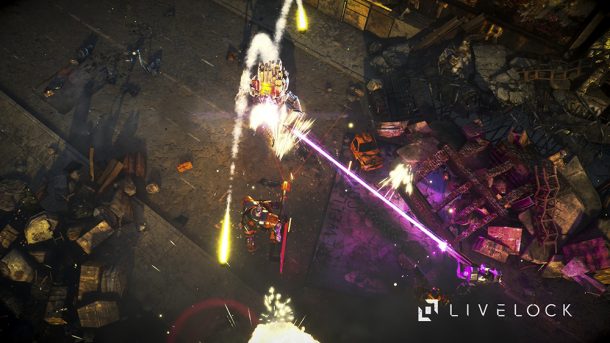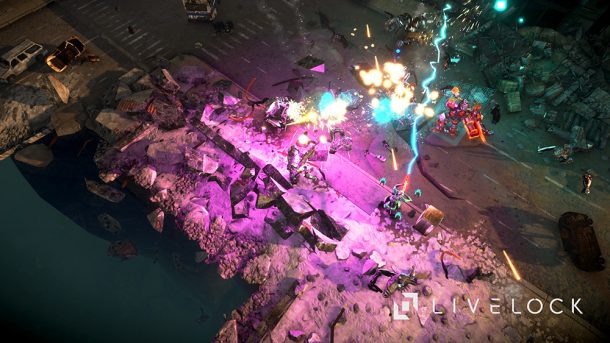One of the interesting things about Perfect World & Tuque Games’ Livelock isn’t necessarily the futuristic setting or the twin stick combat, but perhaps the history that influenced the game. Inspired by games like Dead Nation and Diablo, it’s designed to feel as if it stepped right out of the late Nineties and onto modern devices.
After getting my hands on it at PAX East, it seems to fully achieve that goal and more. It’s solid, it’s buttery smooth, and it’s highly accessible — all without sacrificing the challenge that serves as the backbone of a good isometric action game.

Livelock brings up to three players together, each selecting a different — yet familiar — class. Vanguard is the tank of the group, Hex provides ranged attacks, and Catalyst is the support team member. I chose Catalyst, as I was curious to see how robotic healing and buffs could work. The game is designed around those three characters specifically, Lead Game Designer Kevin Neibert explained to me on the show floor, so that the world and its puzzles don’t throw things at us that would seem out of place. The three specific classes were also chosen because they’re perhaps the most common, adding to the familiar feel of the game.
And, by focusing on just those three classes, the team is able to make them as diverse as possible without the need for more to fill a play gap. For example, the Vanguard busts through walls and enemy alike but still provides an energy shield for the team to stay behind, protected while shooting. My Catalyst can not only leave a regeneration circle to help my team, but can also send drones out to do her bidding and slow down enemies at a distance.
My demo of Livelock played out over 15 minutes in one level, inside what appeared to be an industrial warehouse/factory district. Traversing through the stage was mapped to the left stick and aiming with the right, and not once did I get thumb-locked in trying to coordinate the two. With some tight hallways and swarms of enemies, precise control was of utmost importance, and Livelock didn’t falter. I did manage to get stuck behind a rail down one ramp late in the demo, but that was mostly due to the state of the game (show floor demo) and not design.
As battles took place and swarms of enemies and bullets and explosions filled the screen, things became chaotic but not unmanageable. I never once felt as though I was lost on the screen or my eyes were focused away from my character; to the contrary I was able to almost take even more control of my situation, sending drones out to attack in specific points on the map as I laid down healing circles around my team. Regenerating was important, as the battles left me injured and dying a lot. A LOT. Did I mention a lot? Death in Livelock is interestingly designed. Because we are in control of robots, when a player loses a life they’re allowed to respawn by being “3D printed” back onto the map. Yes, it’s just a traditional respawn, but tying the idea of transferring AI into new bodies actually seems to lend some strange believability to the process of rising like a phoenix.

To keep the playing field level between new and veteran players, characters don’t gain more health or armor as they progress. However, Livelock will instead let us upgrade weapons and special attacks, allowing us to keep our customized loadouts and gear personal to our tastes without giving us an unfair advantage. This way everyone is an effective member of the team and can contribute equally. And even though I was playing with one of the developers on my squad, I felt just as integral to the task with my lack of experience as he was with his hundreds of hours. The Vanguard still needed my support skills and the Hex still needed me to help take down a few ranged foes.
And maybe that’s the biggest selling point to the game. You can die a lot (like I did), miss a lot of enemies (like I did), and start with zero history of the game (like I did), and still feel as though you have as much of a say in how it all plays out as the veterans on your teams. With a main campaign that is 4-6 hours long across three separate acts and built with co-op at its core, it may end up providing the right mix of escapism, challenge, familiarity and accessibility to keep it fresh.
Livelock is coming to PS4, Xbox One and PC later this year.

![[PAX East 2016] Livelock preview: Three’s company, force a crowd](https://www.sidequesting.com/wp-content/uploads/Livelock_Hex_KeyArt_Logo.jpg)

No Comments